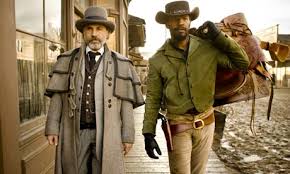Quentin Tarantino's enthusiasm and energetic personality shines just as bright in his interview on "The Treatment," as it does through his films. Quentin Jerome Tarantino is a film director, producer, screenwriter, and actor. He is well known for his trademarks in extreme violence and common themes of revenge in his films. Some of the films he has worked on are
Pulp Fiction, Kill Bill, Inglourious Basterds, and recently
Django Unchained, which are all mentioned in the pod cast. The interview was aired on January 9, 2013.
After listening to Quentin Tarantino's entire interview, I noticed the passion he has for film. If I were to describe my impression of Tarantino in one word, it would be "charismatic." I've learned that viewers such as myself often overlook or don't realize how much work is put into his great films. In his interview, he talks about how he uses food as an important tool, his influences from John Cassavetes, experiences in past films and his latest film, Django Unchained. I've learned that Tarantino takes every little detail and nuances into account of every aspect in his films. I was surprised to hear him talk about these other interesting aspects, as opposed to the usual violence, revenge, and other classical Tarantino themes.
The interview with host, Elvis Mitchell, begins very smooth and candid about the topic of food. At first, I found it a little odd, but Mitchell describes that many of Tarantino's movie's incorporate food in the film. In the third minute of the interview, Tarantino says, "I've always associated like getting to know somebody, trading back and forth, information finding out if your compatible, anything like that always happens over restaurants and diners. I've always found restaurant scenes to be kind of ritualistic." I believe this quote is very noteworthy because all of Tarantino's films feature one or more scenes in a restaurant or a dinner, such as in Pulp Fiction, Inglourios Basterds, and Django Unchained. I've never noticed until now, how important those scenes were to the film and how they portray the shifting of power or the establishing of power. Looking back and reflecting on all his films with scenes incorporating food has helped me create a deeper appreciation for his attention to detail.

In regards to Quentin Tarantino's latest film, Django Unchained, he says "In every way, you are supposed to be on Django's journey, your on Django's side...identifying with Django, his victory is your victory, when he does what he does, your cheering for him, your happy for him." This noteworthy quote pretty much sums up they way Tarantino makes you feel about all the likable character's in all his films, whether they are good or bad. I believe that when viewers make that connection, it is almost as if you know and have that relationship with that character. It draws you into the movie and lets you experience all the same ups and downs as the character throughout the journey in the film. Most of the time, the connection we create is so important, that it makes all the difference when deciding if we believe a movie is good or not.


Towards the end of the interview, you really get a great sense of how much Tarantino cares about how people interpret and react to his films. It is extremely noteworthy that he bases the successfulness of his screenings by watching the film with an audience and observing their reactions throughout the movie as well as the ending. If they do what he expects them to do, it was a success. A perfect example is when Quentin Tarantino says, "If my movies are working to the best of my ability, I feel like that I'm a symphony conductor and the audience's emotions are my orchestra, that's the symphony."

In my opinion, the value of what Quentin Tarantino had to say was very insightful. His interview truly shows his great knowledge of film with the willingness to still learn more. It's very easy to see why he has been a guest on KCRW's "The Treatment" multiple times. Tarantino's style is very different from anyone else and extremely entertaining. He takes old forms of storytelling and techniques, and transforms them to something very new and unique. And although he usually plays a small role in all his films as a cameo, his contributions to the film world are huge.



